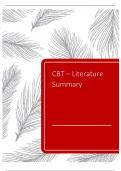Summary
Cognitive Behavioural Therapy (CBT) - Literature Summary
- Course
- Institution
- Book
Literature Summary for the Clinical Psychology Master's course Cognitive Behavioural Therapy (CBT) at Utrecht University (Year 2023/24). Covers the complete Beck book and all mandatory articles in depth
[Show more]




